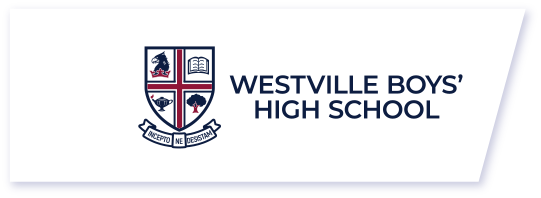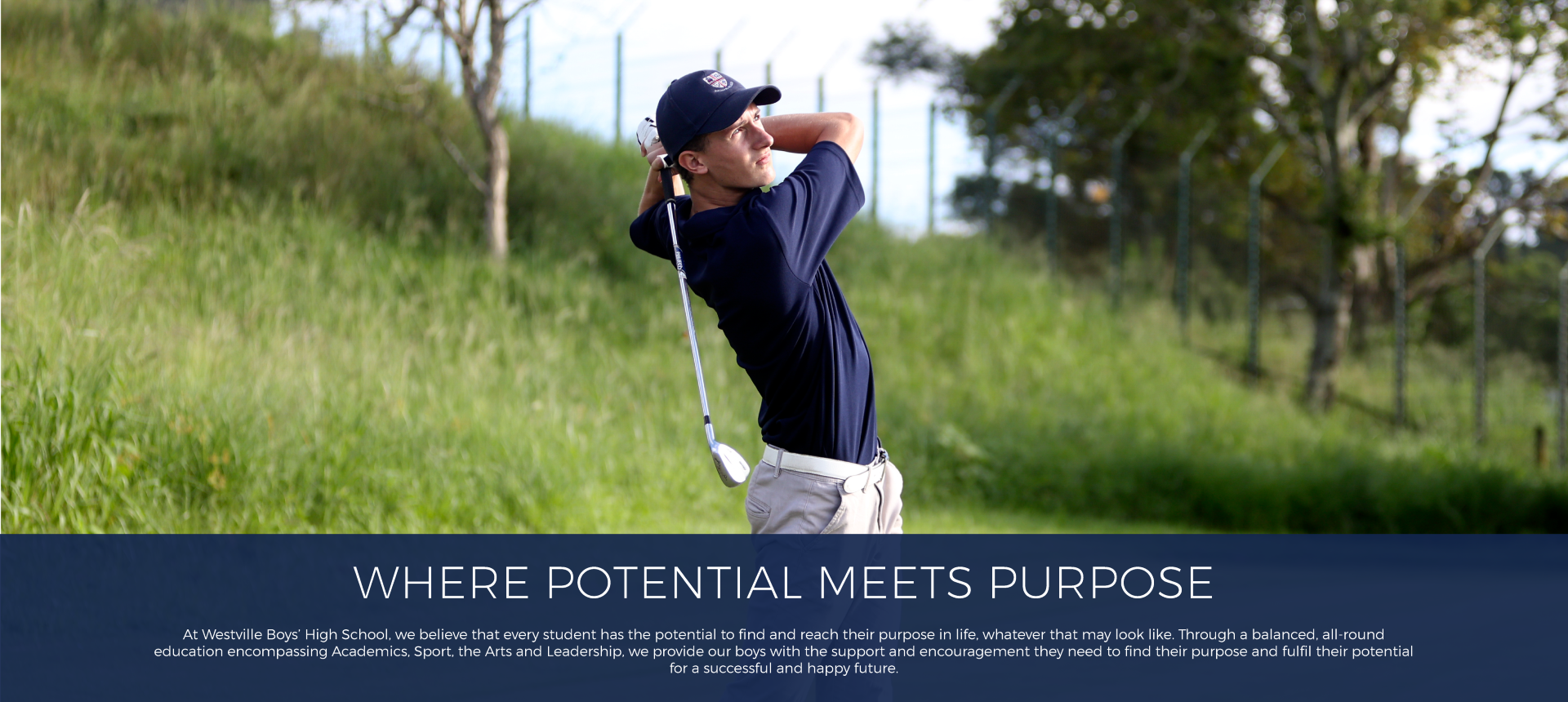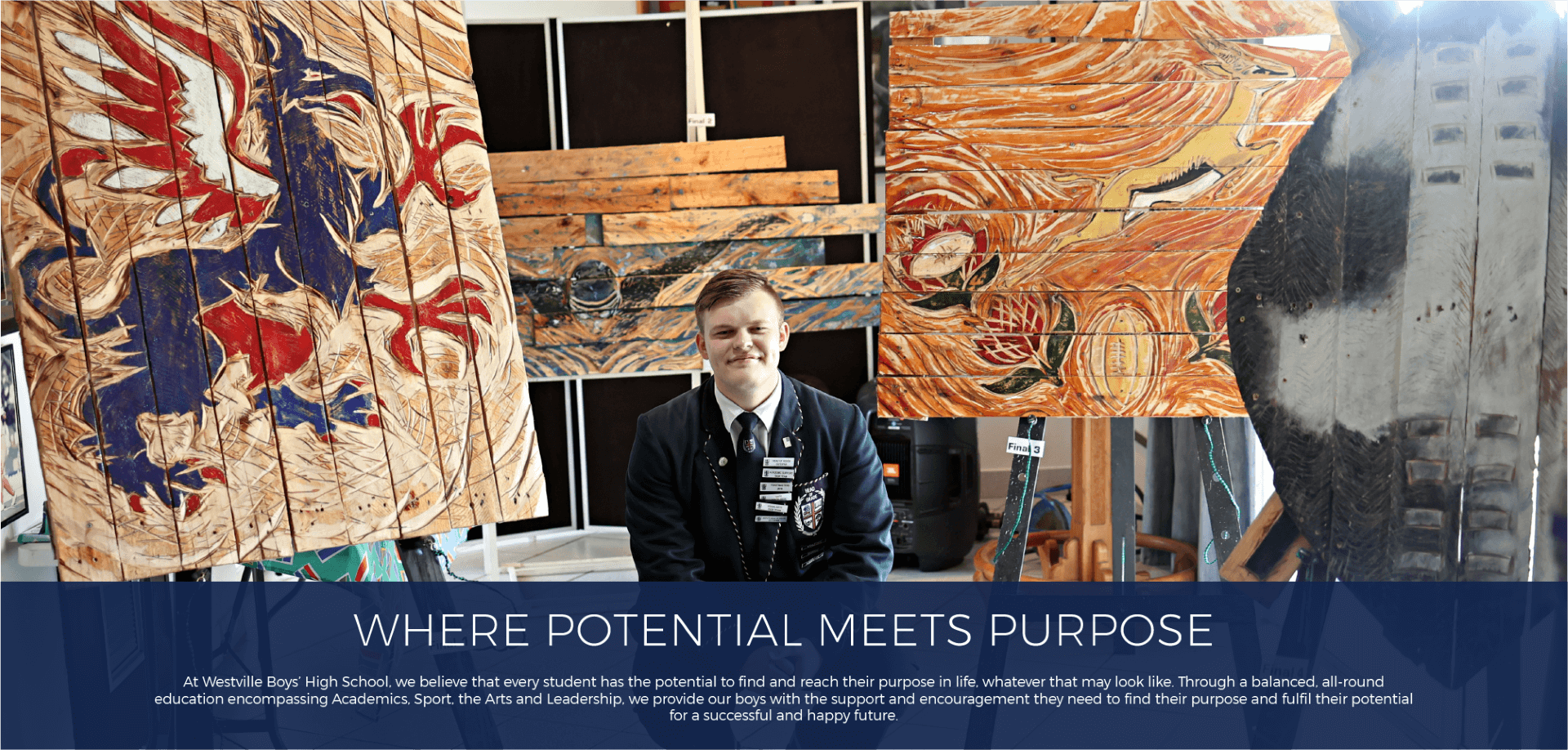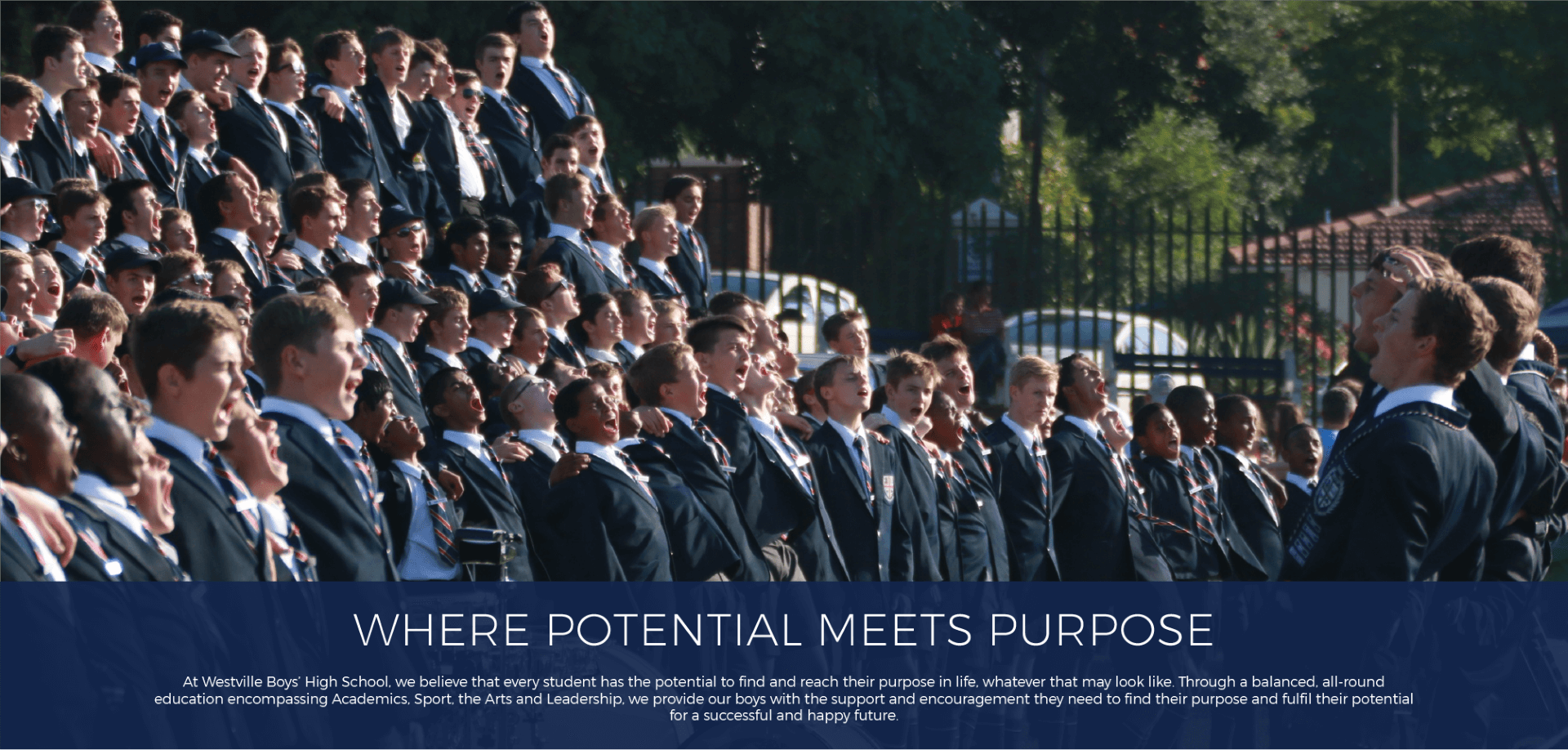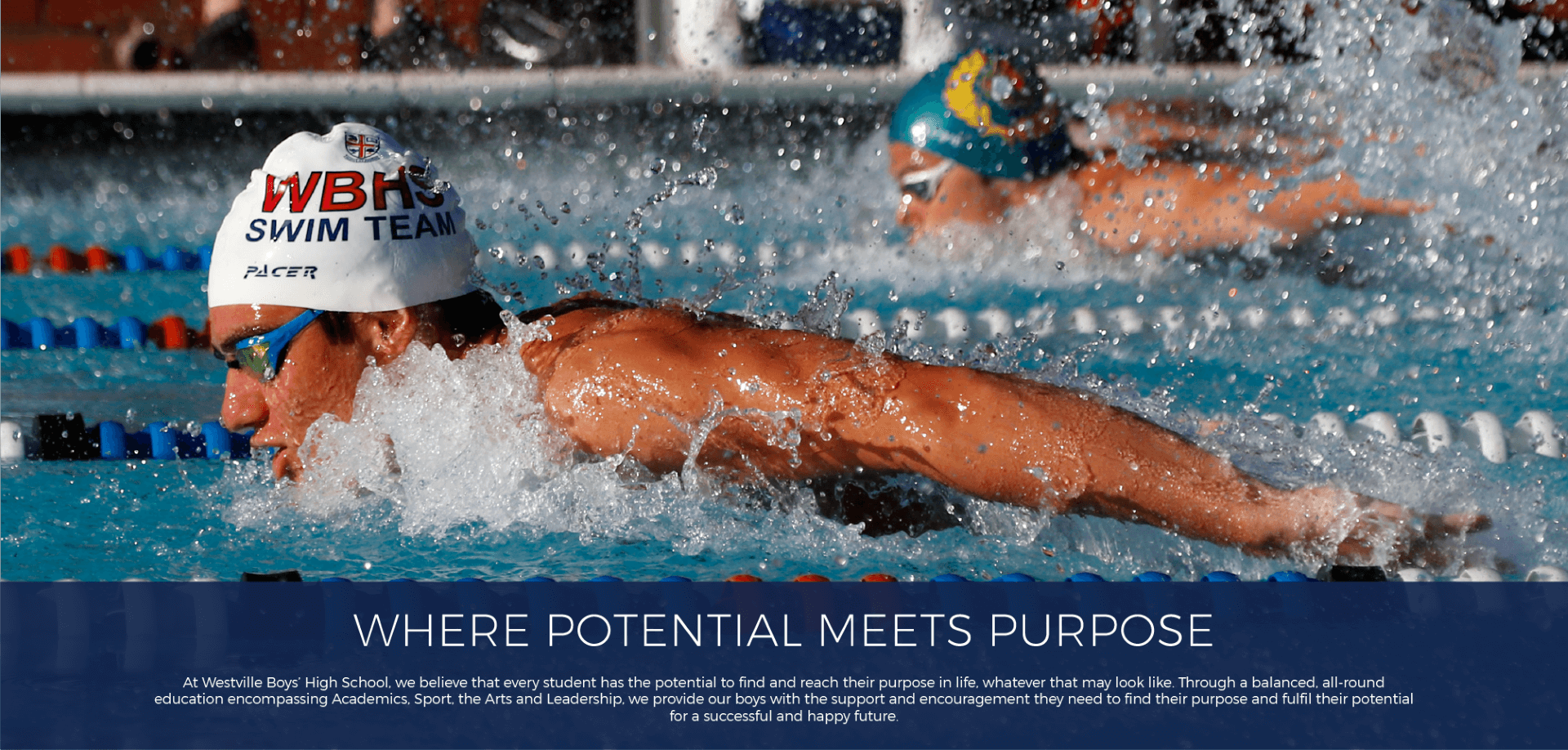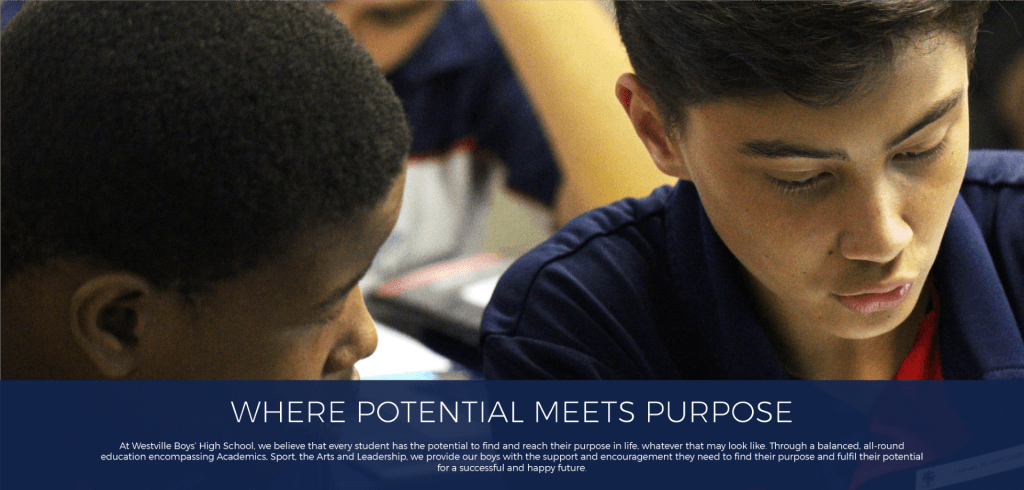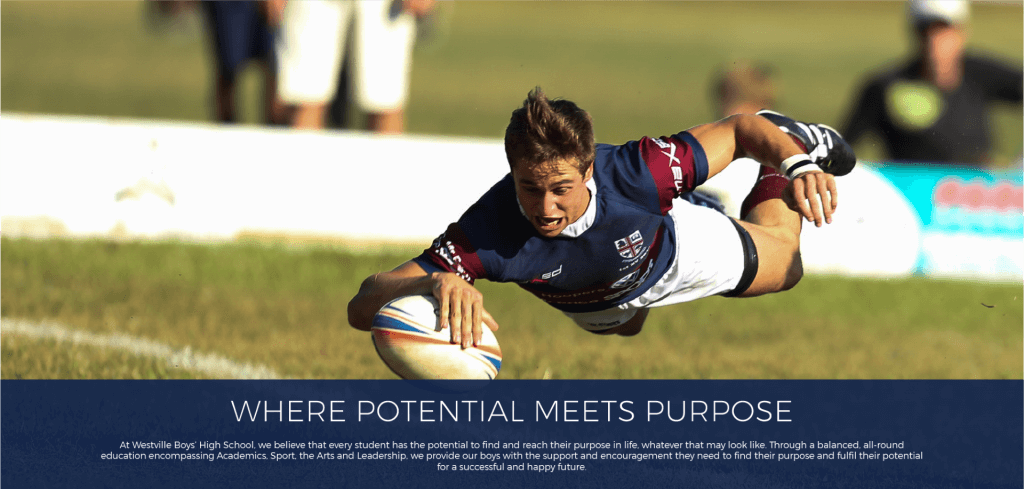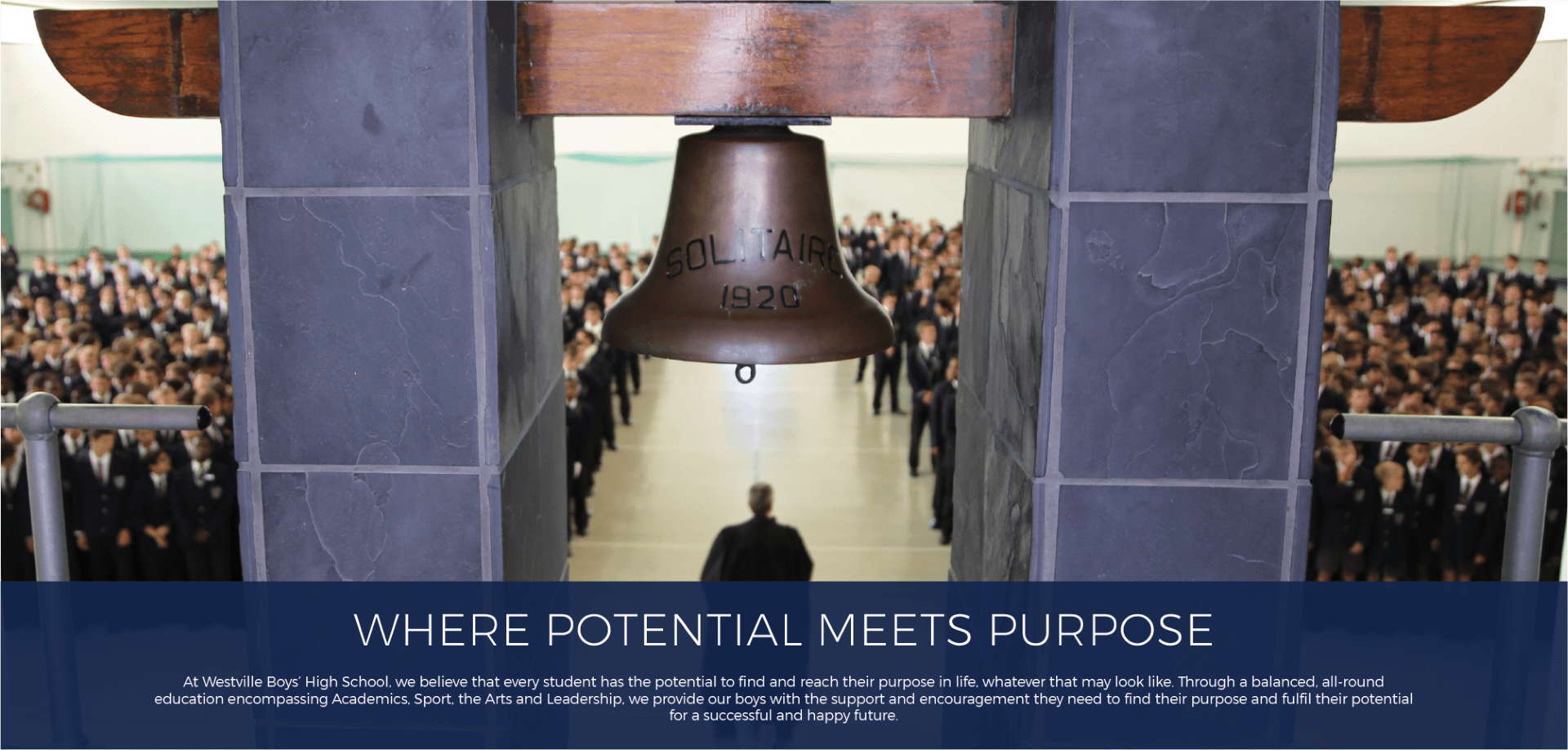School History

![]() School History
School History
Westville Boys’ High School (WBHS), and its predecessors, have a proud record of serving the educational needs of the Westville community. Its history is closely linked to the development and growth of the community. 2014 marks the 60th year of high school education in Westville.
The below timeline records the significant events in the history of education in Westville. From the 1860s to the 1954 only primary education was offered in the community. On the site of where WBHS stands today, primary schooling started in 1941. In 1955 the Westville High School opened its doors for the first time. It operated for ten years before the School was split into two single-sex schools, Westville Boys’ High School and Westville Girls’ High School. WBHS traces its official history back to the start of Westville High School.
| 1861 | The first record of the school in Westville was mentioned in Natal Mercury of 18 March 1861. The first classes were held in the meeting hall used also for Sunday Church services. This 9 by 4 metre wattle and daub structure was built by the German immigrant farmers and sited on the main Durban-Pietermaritzburg road. |
| 1935 | The next recorded date of a school in Westville was March 1 1935. On her 21st birthday, Miss Gladys Carr (Later Mrs. Cooke), a newly qualified teacher, rang her school bell in the same Church hall (on the site of the present town Engineer’s office). She had six kindergarten pupils at the outset. |
| 1936 | Six more pupils enrolled and the school kindergarten graduated to a “Farm School” and was entitled to a provincial grant of 60 pounds per annum. |
| 1938 | The school became a Government–aided institution and moved into the back of the new administration offices, its “home” until 1941. It was at this time that the junior school’s colours were decided upon- blue and white. |
| 1941 | The school was moved to Bernard’s House, an old house situated on present school site. This residence on six acres of land had been educational purposes. In 1941 Miss Carr had fifty pupils and four staff members – her sister Miss Pat Carr, Mrs. Selfe, Mrs. Murray and Miss Cornelius. The school extended to standard IV, with standards II, III and IV grouped as one class. |
| 1944 | The school had now acquired reputation for providing an excellent grounding and by 1944 the school roll had increased to sixty-six. The provincial administration talked about opening a new school and Miss Carr decided that the days of her private school should end. Following a highly successful school concert, Miss Carr’s school closed at the end of 1944. |
| 1945 | The school reopened as a provincial school with Miss Fitzgerald as Headmistress. |
| 1947 | Mr F.H. Lumsden succeeded as Principal and made it his task to improve the school grounds. In the same year, the School’s Parents’ Association was formed and, with considerable foresight, began to formulate plans for the expansion of the School. It was not long before the School was able to offer schooling up to the Standard V level. The first two school houses, Carr House and Wandsbeck House, were created. These Houses remain school houses of WBHS to this day. |
| 1948 | Mrs. E. Edminson succeeded Mr. Lumsden, at a time when it was decided to erect a new school on the site. |
| 1949 | By this time there were 166 pupils on the roll. With accommodation stretched to the limits, 43 younger children worked in a room above the town hall, under the guidance of Mrs. Pat Stockil. |
| 1950 | On 24 January, 229 pupils assembled in the new building and on 1 March, Dr R. Banks, Director of Education, formally opened the school, exactly 15 years after Miss Carr had first inaugurated her school. |
| 1951 | Mr. V. Millard became the new headmaster and remained until his retirement at the end of 1954. During this time the school grew with the same rapidity as the village. A Standard VI was added and a new wing was built on to the school. |
| 1955 | Mr. N.W. Bowden became the first headmaster of Westville High School and began to lay the foundations of a secondary department and to guide the fledging school eventually to full high school status. |
| 1956 | The requisite number of pupils was reached for a standard VII class but not without considerable difficulty. By the time Mr. Bowden left Westville in 1963 the roll had increased from 21 to 797, from staff of 3 to a complement of 42. A new school uniform was designed along with a new badge. |
| 1957 | The school acquired its first memorial, the Charles Swain memorial bell. Gradually physical amenities were added. Boys and girls no longer had to change for sport in the classrooms – a ‘ticklish’ exercise requiring careful co-ordination by staff and pupils and source of great concern to parents – as new change rooms were completed. The fourth school house, Swain House, was created. |
| 1959 | The first matriculation class in the School’s history wrote the public examination in November 1959 and achieved a quite astonishing record. The Westville 1st rugby XV began competing for the first time. Of the WBHS’ rugby rivalries that exist in current times, the rivalry against the Kearsney 1st XV started in this year. |
| 1961 | The last of the infant and primary classes were accommodated in separate institutions. Lahee Park in Pinetown served as the rugby ground. When, at last, work commenced on what is now Bowden’s Field, the Building Provincial Services provided two bulldozers but only one operator. Reveling in his dictatorial position, the operator took twelve months to level the field and thereafter a further period of months elapsed before the surface was grassed and ready for use. Without a proper school hall, assemblies and parents’ gatherings were held in the area, which now serves as the school’s foyer, and speech days were held in the local MOTH Hall or the Westville Town Hall.Commons’ Field was expeditiously leveled by a private contractor, and the pastoral scene, with cows grazing in the school precincts, was lost along with the demolition of the massive water tower which was removed when building commenced on the school hall in 1962.The pavilion and scoreboard were built on the main field, which soon became a gathering place for Westvillians on a Sunday afternoon to watch the rugby matches against visiting schools. The main field served both as cricket oval and rugby fields and must rank as one of the most attractive in the province.The first school magazine was published, recording the events of 1960. It was edited by Mr. R. Hurworth, with a preface written by the Director of Education, Mr. L. Biebuyck. |
| 1963 | This year marked two radical changes in the school’s history. Mr. Bowden was promoted to the position of principal of the Natal Teachers Training College in Pietermaritzburg, and the building commenced on a Westville High School for girls. Also during this year, building commenced on a three-storey complex overlooking the tennis court, a building program that was developed at a rapid rate of expansion over the next ten years. |
| 1964 | Mr. Bowden was succeeded as Headmaster by Mr. H. J Commons who had in effect served as Vice-Principal over the previous seven years. 1964 was indeed the start of a new chapter in other ways. With the construction of a new High School for girls, only those female pupils who were writing the Matriculation and Junior Certificate Examination, 135 girls in all, remained till the end of the year. |
| 1966 | For six months the Vice-Principal, Mr. Burnett, acted as Headmaster, while the school awaited the arrival of Mr. D. C. Thompson, promoted from Newcastle High in July 1966. Mr Thompson’s reputation as a disciplinarian preceded him, and during his tenure the reputation of the School as a well-ordered and respected high school became accepted by the wider community. The school’s 1st rugby XV went on its first ever international tour, to Rhodesia (now Zimbabwe). Westville pupil, P. Van Zyl won a silver medal in the Mathematics Olympiad. |
| 1963 | This year marked two radical changes in the school’s history – Mr. Bowden was promoted to the position of principal of the Natal Teachers Training College in Pietermaritzburg, and the building commenced on a Westville High School for girls. In 1963 building commenced on a three-storey complex overlooking the tennis court, a building program which was developed at a rapid rate of expansion over the next ten years. |
| 1964 | Mr. Bowden was succeeded as Headmaster by Mr. H. J Commons who in affected had served as Vice-Principal over the previous seven years. 1964 was indeed the start of a new chapter in other ways. With the construction of a new High School for girls, only those who were writing the Matriculation and Junior Certificate Examination, 135 girls in all, remained till the end of the year. |
| 1965 | Mr Commons was promoted as Headmaster of Maritzburg College giving the impression to many perhaps that Westville was still a rung below the established schools. Yet it was a promotion well-merited for Mr. Commons – an outstanding Mathematics teacher and administrator. |
| 1966 | For six months the Vice-Principal, Mr. Burnett, acted as Headmaster, while the school awaited the arrival of Mr. D. C. Thompson, promoted from Newcastle High in July 1966. Mr Thompson’s reputation as a disciplinarian preceded him, and during his tenure the reputation of the School as a well-ordered and respected high school became accepted by the wider community. The school’s 1st rugby XV went on its first ever international tour, to Rhodesia (now Zimbabwe). Westville pupil, P. Van Zyl won a silver medal in the Mathematics Olympiad. |
| 1968 | Westville pupil, H. Schumann was awarded first place in the National Science Week. In the same year he achieved the top place in Natal in the matric examinations. Westville pupil, R. Rogers, became the school’s first Natal Schools cricket cap. |
| 1969 | Westville pupil, T. Davidson, achieved the top place in Natal in the matric examinations. |
| 1970 | Westville pupil, G. Watkins, achieved the top place in Natal in the matric examinations. This was the third year in row that a Westville pupil had occupied the top spot. R. Rogers became the school’s first SA Schools cricket cap. T. Cocks became the first Westville pupil to represent Natal Schools at both cricket and rugby in the same year. |
| 1971 | The new Headmaster, Mr. C.D Harcourt, promoted from Brettonwood High School, settled in quickly and was to steer the school through further important advances. Mr. A.J Wilkinson, also previously from Brettonwood, became the school’s first Deputy Headmaster in 1971. |
| 1971 | A start was made to building additions amounting to more than half a million rands. These included classrooms, general-purpose rooms, five new science and biology laboratories, a team teaching room, a new library and staff room. The end of 1971 marked the retirement of Mrs Pat Stockil after 25 years of service to Westville. |
| 1972 | Westville pupil, R. Davidson, achieved the top place in Natal in the matric examinations. A Standard IX pupil, S. Erasmus, came first in the National Youth Science Examination. |
| 1973 | Westville pupil, S.Erasmus, came first in both the Mathematics Olympiad and the National Youth Science Exam. At the end of 1973 Mr. Harcourt was promoted to the Inspectorate after all-too-short a stay at Westville. |
| 1974 | Mr. R.W.H Barry acted as Headmaster in a year which witnessed successes in spheres not so traditional to WBHS. In the Matriculation Examination, Westville achieved 23 distinctions in History, believed to be an all-time record in South Africa for a single subject at the time. Also during the year, the school acquired its own swimming pool, thus fulfilling a long overdue need in a school of 900 boys. |
| 1975 | Mr P. Doyle arrived from Kingsway High as the fifth Headmaster of Westville. Mr M.J.P. Maher was promoted from Vice-Principal to Deputy Headmaster, after Mr R. Barry had been added to the list of émigrés promoted to the rank of Headmaster of another school. Westville pupil, P. Dobson, became the first Westville boy to win the Jan Hofmeyr speech contest. |
| 1976 | The Westville cross country team went on a tour to the USA, becoming the first school cross country team from South Africa to conduct such a tour. The Westville cross country team won every Natal Schools Championship from 1972 to 1976. |
| 1978 | Due to the growth in extra-mural activities, two further school houses were added, Hofmeyr and West Houses, taking the total number of houses up to six. |
| 1980 | T. Cocks became the first Westville Old Boy to win Springbok rugby colours. |
| 1982 | C. Swart, who matriculated in 1976, became the first Westville Old Boy to win the Rhodes Scholarship. Westville pupil, W. Goddard, won a silver medal in the Mathematic Olympiad. |
| 1983 | Mr. Doyle elected to retire mid-year. His successor as Headmaster was no stranger to the school. After a two year absence, as Deputy Headmaster at Durban High School, Mr. R.W. Couzens succeeded in July as the sixth Headmaster of Westville. Mr Couzens’ passion for the School endeared him to all in the community. His ability to bring out the best in others ensured that the School rose to new heights of achievement in academics and sport. Westville pupil, D. Van Rooy won a silver medal in the Mathematics Olympiad. |
| 1984 | The WBHS Educational Trust was launched in May 1984. The initial fundraising target of R350 000 was reached in 16 weeks. Westville pupil, P. Willies, came first in the Hoër Taalbond Eksamen. |
| 1986 | The WBHS Educational Trust was launched in May 1984. The initial fundraising target of R350 000 was reached in 16 weeks. Westville pupil, P. Willies, came first in the Hoër Taalbond Eksamen. |
| 1987 | Mr. T. W. Hall was appointed as Deputy Headmaster – the first WBHS old boy to be appointed to this position. Two Westville pupils, E. Stewart and A. Hawley, became the first Westville boys to be selected for the SA Schools rugby team. E. Stewart in the same year won selection to the SA Schools cricket team. The Westville tennis team, made up of E. Ferreira, K. Haygarth, R. Mills and R. Koenig, won the first ever South African Schools Tennis Tournament. The Westville athletics team won the D&D ‘A’ Athletics Meeting for the first time in the School’s history. |
| 1988 | Westville pupil, P. Hunter came top in Natal and sixth in the country in the Science Olympiad, and third in the Computer Olympiad. The Class of 1988 was arguably the best matric class up to that point in the school’s history. Four pupils featured in the Top 30 in the province, and 22 of the 188 candidates achieved ‘A’ aggregates. |
| 1989 | The Headmaster, Mr Couzens, was promoted to the Inspectorate. He had dedicated 25 years of his life to the school. The Westville 1st water polo team won the prestigious SACS Tournament for the first time. |
| 1990 | Mr. K. Elliot arrived from Kingsway High School as the Headmaster to succeed Mr. Couzens. He resigned at the end of 1990 to enter the tertiary environment. In the year that Nelson Mandela was released after 27 years of incarceration by the Apartheid State, the parents of WBHS were provided with the opportunity by the government to vote to open the School to pupils of all races. At a meeting of parents late in the year, the parent body voted overwhelmingly to open the school. |
| 1991 | At the start of the year the school was opened to boys of all races for the first time. Mr. E. W. Maddams became the Headmaster of WBHS mid-year. Mr Maddams came to Westville from Glenwood with the reputation of being a fine administrator and a gifted teacher of English. His influence was soon felt in the fields of literature and the performing arts. |
| 1992 | In accordance with the legislation of the day, the Governing Body opted to convert its status as a public school to ‘Model B’ status. This meant that the School would become a fee-paying school in terms of the Schools Act, and the Governing Body would be entitled to determine its pupil admissions criteria. The School subsequently converted to the ‘Model C’ status of a self-managing public school. Although this ensured greater freedom in the making of decisions, it led to a decline in funding from the State.Two Westville Old Boys, O. Chalupsky and T. Strydom, became the school’s first Olympians, when they were selected to participate in the 1992 Olympic Games in Barcelona. The school’s 1stsquash team won the SA Top Schools Squash Tournament. |
| 1994 | In the year of South Africa’s first democratic elections, the school’s new Media Centre, overlooking what is today called the Bernard Quad, was opened. It occupied the site of what was previously the Art Room. The Art Centre was relocated to the site of the old Woodwork Room, adjacent to the Tennis courts. Westville pupil, G. Jelbert, came second in the Mathematics Olympiad. The Class of 1994 donated a flagpole that would from then on proudly fly the new South African flag. |
| 1995 | The school’s 1st rugby XV toured Australia and New Zealand, the first international rugby tour in twenty years. |
| 1996 | Following the promulgation of the new Constitution of the country, the new SA Schools Act came into being. WBHS status was once again changed, this time to that of a self-managing high school in terms of Section 21 of the Act. The Headmaster, Mr Maddams, accepted voluntary retirement, after having guided the school through the exciting and challenging first years of South African democracy. Two Old Boys, E. Ferreira and D.Hibberd, were selected to represent South Africa at the 1996 Olympic Games in Atlanta. |
| 1997 | Supported by the Educational Trust, the School opened its new Computer Centre, laying the foundations for the IT development of the future. |
| 1997 | Mr T.W. Hall was promoted to the position of Principal in April 1997, the first WBHS old boy to be appointed to this position. |
| 1999 | A second story of Bowden’s Pavilion was developed, incorporating the Long Room and Griffin Room. A survey of schools in South Africa by the Sunday Times ranked WBHS has the top state-aided boy’s high school in South Africa. |
| 2000 | The WBHS Dux of 1999, C. Bigg was announced as the top 1999 matriculant in the country at a special assembly addressed by the KZN Minister of Education, Mrs N Shandu. Westville Old Boy, G. Morgan, becomes the school’s second Rhodes Scholar. The school’s first football team toured England, its first ever overseas tour.The WBHS Sports Academy was formed to enhance the School’s policy of sport for all pupils. This programme included timetabled sports periods for each grade, programmes for skills development, and advanced coaching for groups and individuals. The School also embarked on the recruiting of experts and consultants to raise skills levels of players and coaches. These strategies led to an immediate increase in demand for sport at WBHS. The increased achievements of WBHS pupils in gaining selection for provincial and national representative sides are testament to the initiatives of the Sports Academy |
| 2002 | Pharos Medical Plan started a 5-year association with the School as the major sponsor of the WBHS Sports Academy. |
| 2003 | The pupil leadership structures in the School were reviewed in line with the concept of ‘Servant Leadership’. The system of Prefects, associated with the school since 1959, were removed and replaced by a new empowering system of Pupil Leaders. These Leaders are expected to plan, lead, organise and serve others in addition to their control function. |
| 2004 | Due to growth in enrollment numbers, two new school houses, Outspan House and Bernard House, were created, taking the total number of houses up to eight. The 1st rugby XV toured Chile and Argentina. |
| 2005 | The School received a R6m donation from an anonymous donor trust for the construction of a Multi-Purpose Centre on the site of the old tennis courts. This facility, completed in 2006, revolutionised the operation of the School in general and the Sports Academy in particular, and provided an ideal venue for assemblies and large-scale dramatic productions. A plan was devised to convert the existing Roy Couzens Hall into a performing arts facility. Westville Old Boy, C. Young, becomes Westville’s third Rhodes Scholar. |
| 2006 | The School led the way in the introduction of the new national curriculum incorporating skills, values and attitudes in addition to knowledge content. Several members of staff were involved in the fine-tuning of the new curriculum. |
| 2007 | The School continued to receive accolades for its academic achievements. WBHS was named by the Minister of Education as the only school in KZN, and one of only 13 schools in the country, to be a member of the elite ‘100 Club’ which recognises schools with more than 100 Higher Grade Mathematics passes in the Matric exams.The Westville 1st water polo team won the prestigious SACS Tournament for the second time. Westville Old Boy, W. Murray, became Westville’s second Springbok rugby player. |
| 2008 | This year marked the first National Senior Certificate (NSC) Examinations under the new revised curriculum. In view of the School’s academic programmes of enhancing teaching in line with new developments in education, it came as no surprise that WBHS pupils dominated the lists of high achievers in the first NSC exams. The School earned the unique distinction of providing the 1st and 2nd placed pupils in the elite Top 10 list of the province. The Dux, M. Schmid, and Proxime Accessit, C. Guattari-Stafford, earned deserved accolades for their high achievement along with the other 17 boys who achieved a full set of seven distinctions or more. Bachelors’ passes were achieved by 96% of the Matric group, enabling them to pursue further study at university. This set a new benchmark for WBHS academic excellence.Sport at WBHS entered a new era of high achievement. The A Swimming team earned the reputation as the top school Swimming team in the country with its first of several undefeated seasons covering the major local and inter-provincial school events. WBHS boasted its first schoolboy member of the South African Olympic Games team when C. Ho was selected for the Open-Water Swim in the 10km event, finishing in a creditable 7th place in the Olympic finals in Beijing.The WBHS Trust provided financial support to acquire a mortgage bond to enable the purchase of a residential property, 101 Jan Hofmeyr Road, to house 20 boarders. |
| 2009 | WBHS received further academic accolades. The School was one of 12 schools nationally to receive a lucrative Anglo-American Award for the quality of its Mathematics and Science results in the 2008 NSC exams. The Alan Gray Orbis Foundation included WBHS in their Circle of Excellence and the School was also invited to join the International Forum of Leading Schools. The Headmaster, Mr T. Hall was invited to join an IFLS panel to present ideas on achieving excellence in holistic education at the IFLS conference in Xi’An China.Arguably the most significant accolade was WBHS being rated as the top boys’ high school in South Africa in the Sunday Times Survey. The survey was commissioned by the Sunday Times in partnership with the Department of Education, and according to the academic criteria used, WBHS was placed 4th nationally behind Westerford (Cape Town), Pretoria Meisies Hoërskool and Westville Girls’ High, earning WBHS the position of the top boys’ school nationally. No other boys’ high school in the province was placed in the national Top 10. WBHS was also honoured with placement in the Top 10 lists of Mathematics and Science schools, the only school in the province to achieve this distinction. |
| 2010 | By this time, the performing arts were also starting to emerge as a major point of difference for WBHS in comparison to most other schools. The Educational Trust funded the redevelopment of the Roy Couzens Hall into a fully-fledged drama theatre named the Roy Couzens Theatre. The first major production staged in the redeveloped facility was High School Musical 2, an ambitious and hugely successful collaboration with the Durban City Orchestra. The School’s top sportsmen continued to impress. Swimming Captain, C. Le Clos, a matric pupil, was selected to represent South Africa at the Junior Olympic Games and the senior Commonwealth Games. He distinguished himself as a multiple gold-medal winner at those events, and set a Commonwealth Games record in the process. |
| 2011 | The School’s academic reputation was further enhanced following the release of the 2010 NSC Matric results in the first week of the year. Three WBHS pupils were placed in the elite Top 10. The School received a grant of R800 000 from the National Lottery Distribution Fund for the purpose of developing an Aquatics Centre to do justice to the prodigious talent emerging in the sports of Swimming and Water Polo. |
| 2012 | Westville Old Boy, C. Le Clos, won a gold and silver medal at the 2012 Olympic Games in London. The SA swimming team was coached by Westville Old Boy G. Hill, with two further Old Boys, L. Shankland and C. van Zyl Crous featuring in the team. Le Clos, Shankland and Van Zyl Crous made up three of the four spots in the SA 4x100m Medley relay team.The Westville 1st cricket XI won the KZN T20 competition and represented the Dolphins franchise at the national competition. |
| 2013 | Westville Dux, Asil Motala, was the top matriculant in KZN and South Africa in the 2013 NSC examinations. The Westville 1st cricket XI won the KZN T20 competition. Westville pupil, S. Sangweni-Fynn won the KZN Best Speaker Competition. The Westville 1st rugby XV beat Maritzburg College 50-10 at Goldstones, only the second time the 1st XV had ever won away against College. |
| 2014 | The Westville 1st cricket XI won the KZN T20 competition for the third time in a row. The Westville A Swimming team achieved its seventh year of being unbeaten across all galas it had competed in. Westville Old Boy, M. Mea, became the School’s first senior SA hockey player. Westville pupil, J. Bleeker, was selected to captain the SA U18A Boys Hockey team, becoming the first Westville pupil to captain a national hockey team at any level. |
